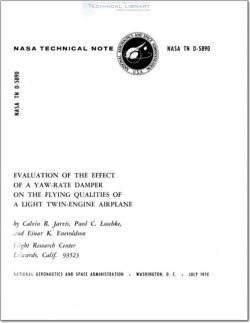NASA-TN-D-5890

- Version
- 232 Downloads
- 1.88 MB File Size
- 1 File Count
- June 15, 2016 Create Date
- June 15, 2016 Last Updated
Evaluation of the Effect of a Yaw Rate Damper on the Flying Qualities of a Light Twin Engine Airplane

A simple, parallel yaw damper and aileron —to —rudder interconnect was tested in
flight in a light twin—engine airplane to evaluate the improvement that might be achieved
in the overall flying qualities of a general —aviation airplane in turbulence. Fifteen
pilots participated in the evaluation program. Both quantitative and qualitative data
were obtained for evaluation of lateral —directional characteristics.
The yaw damper significantly reduced the short—period lateral —directional motions
of the test airplane in turbulent air. This resulted in an improvement in both the ride
and the flying qualities. The improvement in the pilot's overall performance of the
ILS approach task was not significant.
The aileron—to —rudder interconnect was found to be effective in compensating for
adverse aileron yaw, and turns could be made easier and more accurately.
An increase in the intensity of the lateral motions of the test airplane in turbulence
was experienced when the autopilot system was used alone. The autopilot performance
in turbulence was significantly improved when the system was used with the yaw damper.
Maximum roll and yaw rates encountered during stall maneuvers were reduced
when the yaw damper was operating. Also, the available time for corrective action fol—
lowing a simulated engine failure was effectively doubled when the yaw damper was
engaged.
The NASA Flight Research Center recently conducted a handling—qualities survey
(ref. 1) of a representative cross section of general—aviation aircraft. This study
indicated that personal —owner aircraft have generally satisfactory handling qualities
for visual flight and for instrument flight in smooth air, but that atmospheric turbulence
degrades these handling qualities. The degradation was most noticeable during ILS
approaches because of the marked increase in pilot workload. Low lateral stability,
high adverse yaw, and objectionable Dutch roll characteristics are identified in refer—
ences 1 and 2 as some of the stability and control characteristics which degraded
handling qualities. These characteristics, and others, combined to make precise
instrument tracking tasks in turbulence difficult for even the most experienced instru—
ment pilots.
| File | Action |
|---|---|
| NASA-TN-D-5890 Evaluation of the Effect of a Yaw Rate Damper on the Flying Qualities of a Light Twin Engine Airplane.pdf | Download |

Comment On This Post